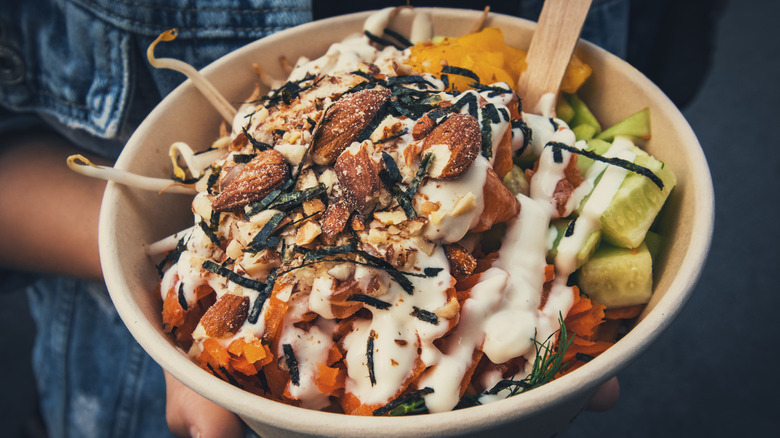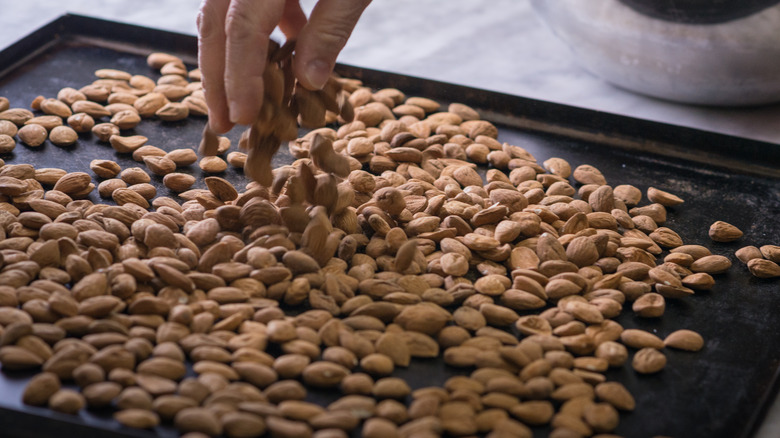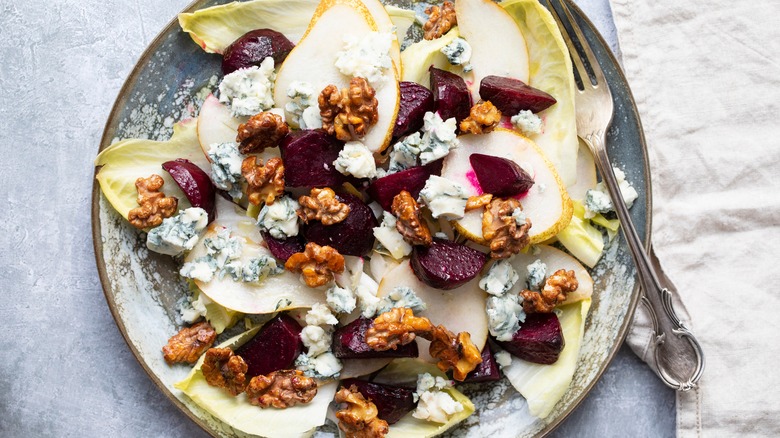You're Missing Out If You're Not Toasting Nuts For Your Salads
With some creativity, you can turn any salad into a culinary delight. Even small tweaks, such as tossing in some nuts or using homemade dressings, can make all the difference. When it comes to nuts, go one step further and toast them in a pan before adding them to your salad. For example, toasted hazelnuts are a perfect topping for fall salads, offering both flavor and nutrition.
Roasted or toasted nuts can add crunch to salads, making them more appetizing. Plus, they're easier to digest than their raw counterparts, helping the body absorb their nutrients more efficiently. For instance, roasting improves the digestion of almonds, contributing to satiety, according to 2009 research published in Food Biophysics. This process decreases their water content, resulting in a crispy texture. At the same time, it gives them a golden-brown color that contrasts beautifully with the vibrant colors of the salad.
The terms "roasting" and "toasting" are often used interchangeably when it comes to nuts. With either method, you'll cook them in the oven or on the stovetop until brown and crunchy. Because they're naturally high in fat, you don't need to add oil. If you're in a rush, roast or toast the nuts in the microwave to save time.
Toasted nuts can make salad more nutritious
Most types of nuts, whether raw or toasted, are high in dietary fiber and protein, two nutrients that promote satiety. For example, almonds boast 6 grams of protein and 3.6 grams of fiber per ounce, while the same amount of pistachios contains 5.7 grams of protein and 3 grams of fiber. Nuts are also rich in healthy fats.
"Adding a small amount of fat to a meal helps slow down the rate at which your stomach empties during digestion," clinician Madelyn Frenstrom, Ph.D., said to Today. "And the longer some food remains in your stomach, the longer the sense of fullness lasts — sending that signal to your brain." Moreover, this nutrient serves as a source of fuel and helps the body absorb fat-soluble vitamins.
As discussed earlier, toasted nuts are easier to digest and, therefore, their nutrients are better absorbed into the body. They also have a stronger flavor than when eaten raw, which increases their palatability. Plus, you can toast them with a pinch of cayenne pepper, rosemary, sage, paprika, or other spices to enhance their flavor.
Not all nuts are created equal
Different nuts have different flavors and textures, so you'll want to choose those that pair well with the other ingredients in your salad. For instance, walnuts boast a rich, earthy flavor that complements apples, lettuce, endives, and pears. Cashews are chewy and slightly sweet, which makes them ideal for Asian chicken salad recipes, along with other savory salads that feature noodles, red cabbage, ginger, or coleslaw.
By comparison, toasted almonds are crunchier and more bitter. Therefore, they work best in salads that contain goji berries, cranberries, pears, and other fruits or those containing soft cheeses, which have a neutral flavor. Fall and winter salads will taste amazing if you add toasted pecans. Their sweet and buttery flavor pairs perfectly with Brussels sprouts, apples, squash, kale, and fresh radicchios.
Pine nuts, on the other hand, can be a wonderful choice for Mediterranean salads. They're small, delicate, and tender, with a subtle nuttiness. Hazelnuts have a stronger flavor that can complement fruit salads, especially those made with oranges, tangerines, chocolate, cinnamon, or vanilla. Toasted Macadamia nuts pair well with coconut, pineapple, rambutan, and other exotic fruits, making them suitable for tropical salads.


